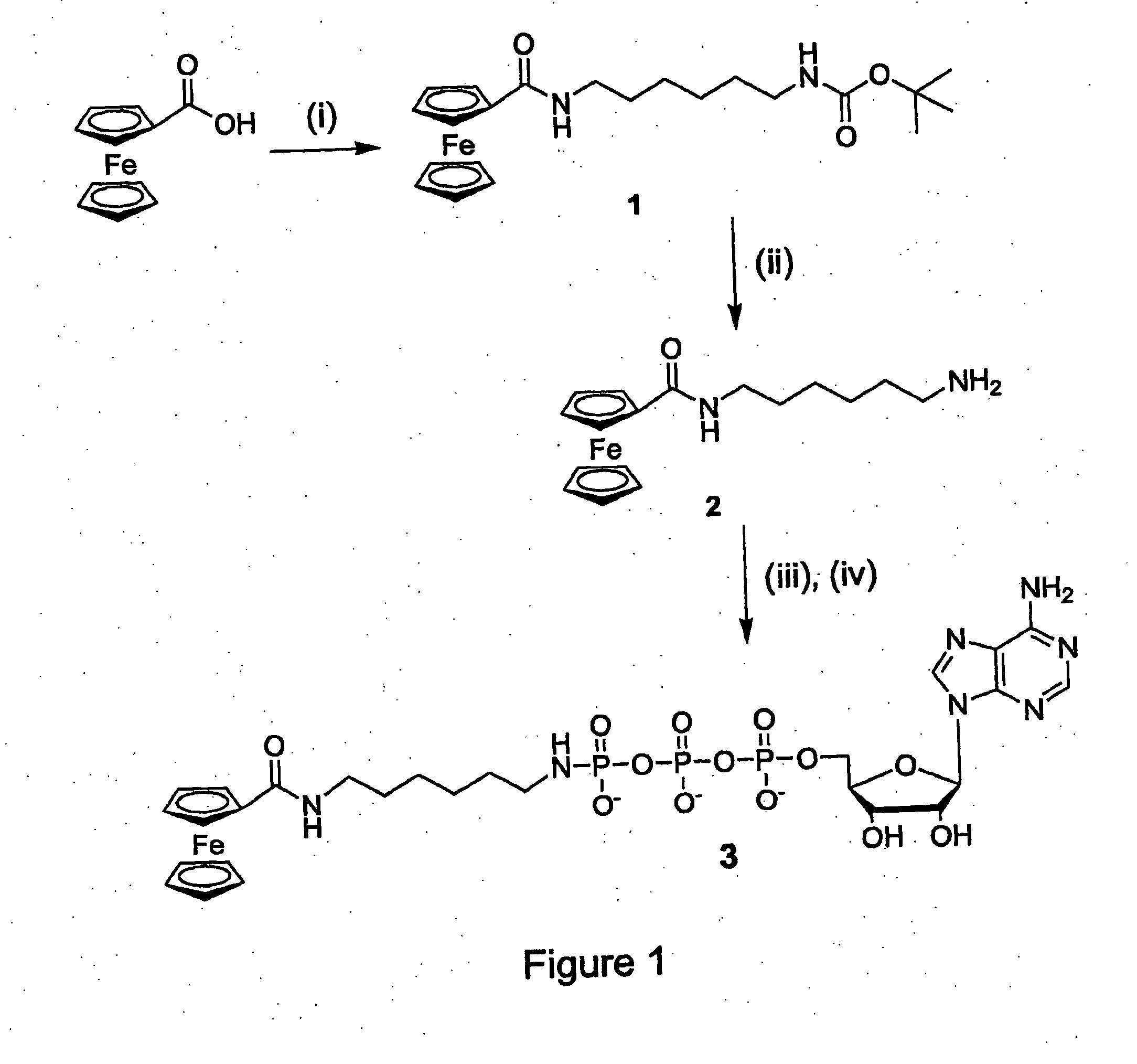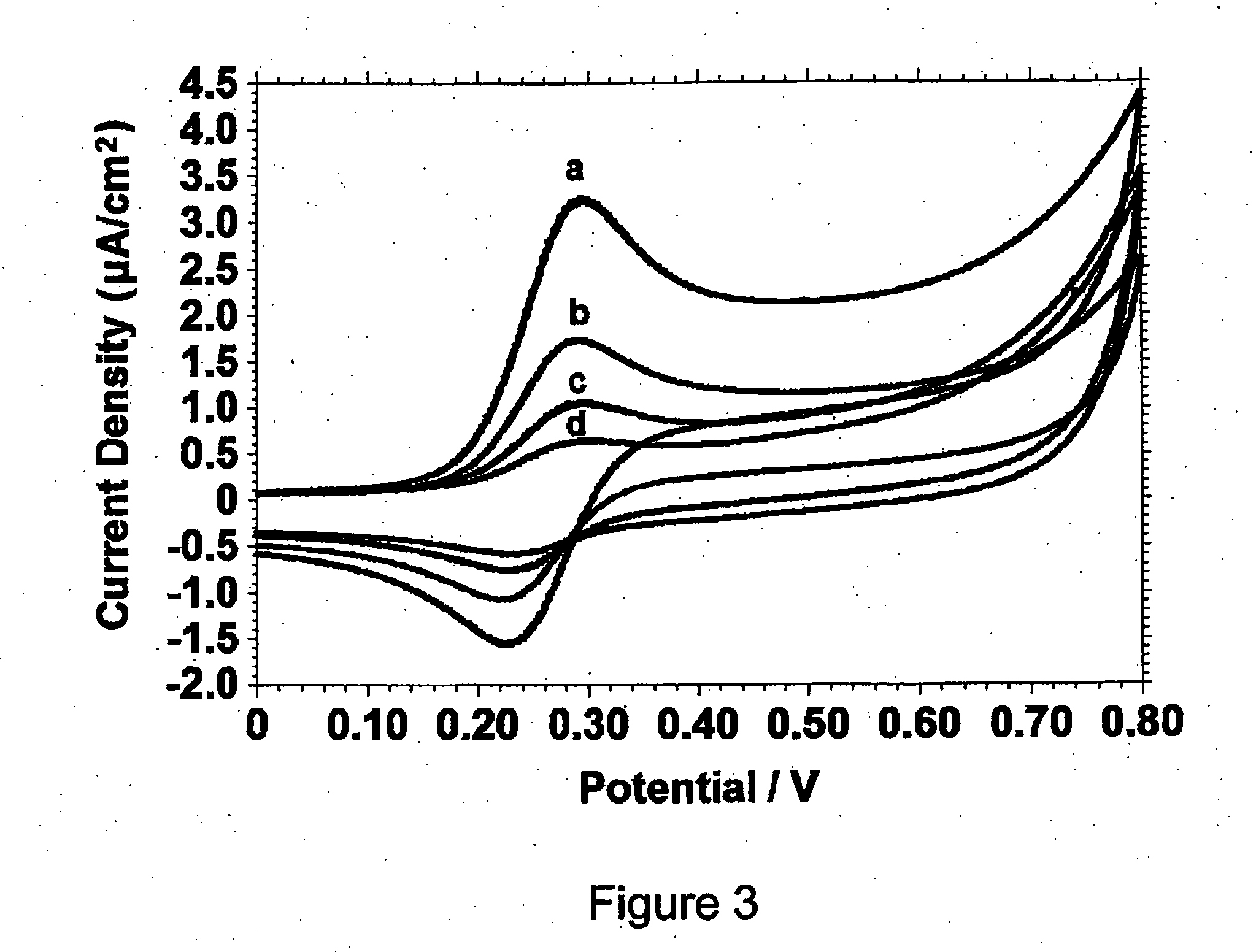Nucleotide triphosphate with an electroactive label conjugated to the gamma phosphate
a nucleotide triphosphate and electroactive label technology, applied in the field of new electroactive nucleotide triphosphate, can solve the problems of increasing cost, tedious and time-consuming handling procedures, etc., and achieve the effect of simplifying and speeding up the procedures involved and reducing costs
- Summary
- Abstract
- Description
- Claims
- Application Information
AI Technical Summary
Benefits of technology
Problems solved by technology
Method used
Image
Examples
example 1
Synthesis of Fc-ATP
[0080]Preparation of Boc-NH(CH2)6N(H)COFc (Compound 1): Ferrocenecarboxylic acid (230 mg, 1 mmol) was dissolved in 20 mL anhydrous DCM. Then, 1.2 equiv. TEA (0.17 mL) and 1.2 equiv. HBTU (455 mg) were added sequentially. After 30 min., Boc-NH(CH2)6NH2 was added to the solution and stirring was continued overnight. After reaction was completed, the solvent was removed in vacuo, and the residue was purified by flash column chromatography on silica gel (DCM-MeOH, 95:5; Rf=0.25) giving the desired compound as a yellow solid in 78% yield (334 mg). 1H-NMR (δ, DMSO): 7.74 (t, 1H, J=5.2 Hz, NH—COFc), 6.78 (t, 1H, J=5.4 Hz, NH-Boc), 4.78 (s, 2H, Cp), 4.32 (s, 2H, Cp), 4.14 (s, 5H, Cp), 3.15 (q, 2H, J=6.4 Hz, CH2), 2.90 (q, 2H, J=6.4 Hz, CH2), 1.23-1.52 (m, 17H). 13C{1H}-NMR (δ, DMSO): 168.57, 155.57, 77.27, 76.94, 69.73, 69.23, 68.06, 39.76, 38.54, 29.50, 29.47, 28.26, 26.17, 26.08. IR: νmax=3363 (NH), 3310 (NH), 2976 (Fc), 2934 (Fc), 2861 (Fc), 1687 (CO-OtBu), 1623 (Amide...
example 2
Electrochemical Detection of Protein Kinase C Phosphorylation
[0085]Cyclic voltammetry (CV) was performed using a CHInstruments 660 system (Austin, Tex.). DEP-chips with screen-printed gold electrodes (SPEs) were kindly donated by BioDevice Technology Ltd. (Ishikawa, Japan) and prepared as set out in Li et al. Anal. Chem. 2005, 77 5766-5769. The total length of an SPE was 11 mm, and the geometric area of the working electrode was 2.64 mm2. The reference electrode was a Ag / AgCl past electrode and the counter electrode was a carbon electrode.
[0086]1H, 13C, 31P NMR experiments were performed on a Bruker Avance 500 MHz spectrometer and chemical shifts were referenced to the residue DMSO (2.50 ppm for 1H and 39.52 ppm for 13C) and H2O (4.79 ppm). Mass spectrometry was carried out using a Perkin Elmer-Sciex API 365 instrument.
[0087]Unless otherwise specified, reagents were purchased from Merck. All solutions were prepared and diluted using ultra-pure water (18.3 MΩ-cm) from the Millipore M...
example 3
Detection of Casein Kinase 2 (CK2) and Tyrosine Kinases Abl1 and HER2 / ErbB2 Phosphorylation
[0100]It was previously demonstrated that using the nucleotide triphosphate conjugate comprising an electroactive labelled gamma phosphate group is useful to detect protein kinase C activity using an electrochemical biosensing system. In this example the utility of the nucleotide triphosphate conjugate was used to detect another well-described protein serine / threonine kinase, casein kinase-2 (CK2) and two clinically important tyrosine kinases, Abl1 and HER2 / ErbB2 and to evaluate this method for measuring protein kinase inhibitor potency.
[0101]First the enzymatic modification of kinase-specific peptide RRRDDDSDDD12 for the serine / threonine kinase, CK2 was evaluated using mass spectroscopy with Fc-ATP as the co-substrate.
[0102]FIG. 14 shows MS plot for the kinase-catalyzed phosphorylation of the substrate peptides for (A) CK2, (B) Abl1-T315I and (C) HER2 / ErbB2 using Applied Biosystems 4700 Prote...
PUM
 Login to View More
Login to View More Abstract
Description
Claims
Application Information
 Login to View More
Login to View More - R&D
- Intellectual Property
- Life Sciences
- Materials
- Tech Scout
- Unparalleled Data Quality
- Higher Quality Content
- 60% Fewer Hallucinations
Browse by: Latest US Patents, China's latest patents, Technical Efficacy Thesaurus, Application Domain, Technology Topic, Popular Technical Reports.
© 2025 PatSnap. All rights reserved.Legal|Privacy policy|Modern Slavery Act Transparency Statement|Sitemap|About US| Contact US: help@patsnap.com



